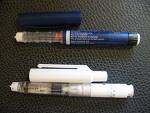 One of the greatest discoveries of the twentieth century which led to their discoverers having the Nobel prize (and sharing it!), this molecule, insulin, is secreted by the beta cells of the islets of Langerhans in the pancreas. It is produced as pre- pro-insulin by genes located on the chromosome 11. It is cleaved and folded to give insulin and C peptide before its release into blood. The pancreatic beta cells have a glucose transporter, called GLUT2 in their cell membrane which senses the blood glucose level and acts accordingly. When blood glucose level goes high, as after meals, glucose enters the beta cells through GLUT2. Thereafter, it is converted to ATP within the cell by metabolism (TCA cycle). This ATP then chokes (inhibits) the ATP sensitive potassium channel located in the cell membrane. Since there is more potassium inside than on the outside, the channel when open allows potassium to go out of the cell. Thus, glucose entry would mean more ATP, and more ATP will close this channel resulting in potassium build up with in the cell. Potassium (K+) being a positively charged ion (cation) will thus decrease the electronegativity inside, causing the cell to fire. As a result, voltage gated calcium channels open. Ca+ plays instrumental role in the exocytosis of insulin (insulin now comes out of the cell into the bloodstream).
One of the greatest discoveries of the twentieth century which led to their discoverers having the Nobel prize (and sharing it!), this molecule, insulin, is secreted by the beta cells of the islets of Langerhans in the pancreas. It is produced as pre- pro-insulin by genes located on the chromosome 11. It is cleaved and folded to give insulin and C peptide before its release into blood. The pancreatic beta cells have a glucose transporter, called GLUT2 in their cell membrane which senses the blood glucose level and acts accordingly. When blood glucose level goes high, as after meals, glucose enters the beta cells through GLUT2. Thereafter, it is converted to ATP within the cell by metabolism (TCA cycle). This ATP then chokes (inhibits) the ATP sensitive potassium channel located in the cell membrane. Since there is more potassium inside than on the outside, the channel when open allows potassium to go out of the cell. Thus, glucose entry would mean more ATP, and more ATP will close this channel resulting in potassium build up with in the cell. Potassium (K+) being a positively charged ion (cation) will thus decrease the electronegativity inside, causing the cell to fire. As a result, voltage gated calcium channels open. Ca+ plays instrumental role in the exocytosis of insulin (insulin now comes out of the cell into the bloodstream).Once it has come out, it circulates in the bloodstream and reaches the target organs/tissues. There it binds with the insulin receptor. The receptor molecule consists of 2 alpha chains (extracellular) and 2 beta chains (partly located extracellularly, partly transmembrane and partly intracellularly). The chains are linked together by sulfur atoms. Insulin binds with the alpha chains (naturally, as they are on the outside) of the receptor molecule, which in turn changes its (receptor) conformation. This triggers tyrosine kinase enzyme activity within the cell. This enzyme is intrinsic to the cell, only its activity is triggered by insulin. Then this enzyme autophosphorylates the receptor (meaning that the receptor itself gets phosphorylated: sounds incestuous!), and molecules such as IRS (insulin receptor substrates) are formed. They in turn phosphorylate/ dephosphorylate cellular proteins to bring about their effects. For example, activation of PI3 kinase (phosphatidyl inositol 3 kinase) results in the translocation of GLUT4 from the cell interior to the cell membrane. This transporter is important in the transport of glucose to the interior of muscle and fat cells. Thus GLUT4 is very important for glucose to enter these cells. Apart from this, insulin also has mitogenic action (by virtue of MAPK activity).
Thus absence of insulin will lead the cells to use fuels other than glucose. Thus the body is depleted of its fat stores, ketone bodies : a byproduct of fat burning are formed, muscles become wasted, and various complications occur.
Previously, insulin from animals (beef, porcine) were used to treat diabetes. Nowadays human insulin from recombinant DNA technology are being increasingly used. They are almost always injected subcutaneously, that too by a device called insulin pen (whence the name of this article). A pen has several disposable needles and a cartridge which may or may not be replaceable. Other routes of insulin administration has been explored, such as nasal, gastric, intrapulmonary by aerosol. Of these, the last mode of delivery holds promise. Insulin has been classified into short acting, intermediate acting and long acting insulins, according to the duration of action, of the type of insulin in question.
Therapy of diabetes often requires more than one component (type) of it (insulin), and is often based on SMBG and HbA1c and clinical parameters, rather than simple calculation on body weight or surface area basis. One example of how different types of insulins are mixed and administered has been sited in my former article, water water everywhere... This is just one example (actual treatment will depend upon SMBG, HbA1c and other informations, as cited above and more).
No comments:
Post a Comment